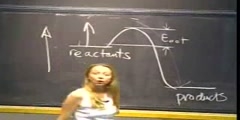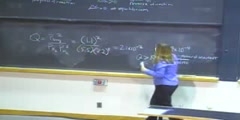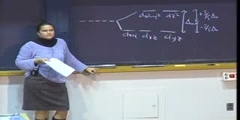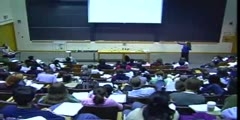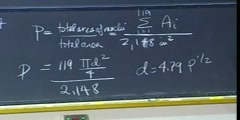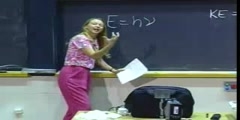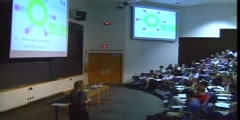A Lecture on P Orbitals
Principles of Chemical Science/n * Email this page/nVideo Lectures - Lecture 8/nTopics covered: /nP Orbitals/nInstructor: /nProf. Sylvia Ceyer/nTranscript - Lecture 8/nWe are going to start with the lecture notes from last Friday because I didn't finish them. What we were doing at the end of lecture last time was probably some of the hardest concepts that we've covered so far in this course, and maybe even in the whole course./nAnd you will remember that we finally got around to talking about what does a wave function mean and how does it actually represent the electron in our hydrogen atom. And we saw that the physically significant interpretation of the wave function was not actually the wave function itself but the wave function squared./nSo psi here, which we learned has to be labeled by three quantum numbers, n, l and m. And that is a function of three position variables, r, theta and phi. If you square that, the physical interpretation of that is a probability density./nThis means this has units. This has units of inverse volume. It's a probability per unit volume. That is very important. It's not a probability but a probability per unit volume. But the other quantity that we would like to know something about is a probability./nWe would like to know something about how far is the electron from the nucleus. And, in order to do that, we needed to invoke this concept here, this radial probability distribution function. And what we said it was last time is a probability of finding an electron in a spherical shell of radius r, and that spherical shell has a thickness dr./nOr, another way to say it is that it's the probability of finding the electron at a distance between r to r plus dr. This is a probability here. And we illustrated that in the following way. This gray portion here, well, that was our density diagram./nThat gray portion was the probability density, psi squared. In this particular case, the 1, 0, 0 wave function, the 1s wave function, we squared it. And then we represented the magnitude of that by that dot density diagram or the density of the dots where that was highest. That represented the highest value of psi squared. And then it radially dissipated exponentially./nThat is what that gray dot density diagram was. And now, if we take a spherical shell and we put it right at the origin where our nucleus is, and that spherical shell has a radius r, and since it is a shell, it is infinitesimally thin, it has a thickness dr here, the probability of finding the electron in that spherical shell is what the radial probability is./nSo it's going to be able to tell us how far, or the probability of finding the electron between r and r plus dr. Now, how do we calculate the radial probability distribution, or how do we calculate the radial probability? Well, the first thing you have to realize is what the volume of this spherical shell is./nThe volume of this spherical shell is just the surface area of the sphere for pi r squared times the thickness dr. That's the volume of the spherical shell. Now, what can I do to calculate the radial probability? Well, we know that psi squared is the probability density, probability per unit volume./nIf I multiply it by that unit volume, in this case 4pr2dr, the volumes here cancel and we have a probability. That's our radial probability. And this is strictly correct for s-orbitals only. There is a little difference here for the p-orbitals and d-orbitals. We're actually not going to do that, but this is our radial probability./nLet's take an example. Let's look at an example of the radial probability for the 1s state. What have we done here to calculate radial probability? We've taken psi squared. We've squared 1s wave function and have multiplied it by 4pr2dr for all these values of r./nWe've calculated psi at all the values of r and multiplied it by 4pr2dr. And the result is this radial probability. That's what I'm plotting right here. What do you see? Well, the first thing you see is that the electron, the most probable value of r, or the most probable distance of the electron from the nucleus is quite a ways out./nThat most probable value is all the way out here where r is equal to a knot. And I said last time that this a knot is a constant. It's called the Bohr radius. And today I will explain why it is called the Bohr radius. It has a value of 0.529 angstroms. So it is most likely to find the electron about a half an angstrom away from the nucleus./nThe most probable value, or the most probable position of finding the electron is not at the nucleus. And, in fact, look at this, that radial probability here is actually zero at r equals zero. That seems a little strange because we looked at the probability density./nRemember we plotted the probability density the last time which was just psi squared for the 1 0 0 wave function as a function of r. And, when we did that, we saw that at r equals zero here, the probability density was some large maximum value and that this exponentially decayed./nWell, the probability density is a large maximum value at r equals zero, but when we look at the radial probability it's zero at r equals zero. Why? Well, because when we go to calculate the radial probability we are multiplying that probability density by a sphere, a sphere whose volume now has shrunk to zero because r is equal to zero./nSo the probability of finding that electron right at the nucleus between r equals zero and r plus dr is zero. So the most likely distance of that electron and the hydrogen atom from the nucleus is one Bohr radius. Actually, then the diameter of that hydrogen atom we typically say is twice the Bohr radius or a little bit over an angstrom./nSo that's what a radial probability distribution function means. It's going to tell us the probability of finding the electron a certain distance r to r plus dr from the nucleus. All right. Now I want to explain to you where this a knot comes from./nAnd that allows me then to also explain a very important concept here about quantum mechanics. By 1911, both the electron and the nucleus had been discovered and scientists were trying very hard to understand how the electron and the nucleus hung together. And it wasn't really until 1926, when Schrödinger wrote down his wave equation that things really began to make sense./nBut there were many attempts in between 1911 and 1926 to understand what was going on with the hydrogen atom. And one of those attempts was made by Niels Bohr./nAnd what Bohr said was well, I know this classical physics predicts that this electron with plummet into the nucleus in 10-10 seconds. That is if I take a planetary model, I put the nucleus in the center and I give the electron a uniform circular orbit around that nucleus, well, I know classical physics tells me this won't hang together./nBut let me ignore that and let me propose that there is something quantized about the hydrogen atom. And he knew that because he knew the hydrogen atom spectrum. He knew that in the hydrogen atom spectrum that light was emitted at only certain frequencies, as we saw the other day. And that gave him the idea that there is something quantized about the hydrogen atom./nSo he then proposed let me go and I'm going to quantize the angular momentum of that electron going around in this circular orbit. So what he did was he kind of took a classical model and he pasted some quantum mechanical ideas onto the system./nAnd when he did that the value for r here, at which the electron was going around the nucleus, well, that value of r ended up being what we call here the Bohr radius now, this value of a knot. Now, we're not going to study the Bohr atom because it's wrong. And, in particular, what it gets wrong is the radial probability distribution./nHere is the radial probability distribution function as it comes out of solving the Schrödinger equation for an electron in this 1s state. But here is the radial probability distribution function for what's called the Bohr atom. The radial probability, I will just write it as RPD. The RPD here is going to be a whopping one right at r=aO./nThat's the radial probability distribution for the Bohr atom. What that tells us is we know exactly where the electron is. What that tells us is that we know exactly that the radius of that electron in that circular orbit is a knot. This is what we call a deterministic picture. That is we know exactly where the electron is in terms of its radius./nHowever, we now know that what's really going on is that we don't know exactly where the electron is. We cannot tell you exactly what the radius is. The best we can tell you is a probability of finding the electron within some value r to r plus dr./nQuantum mechanics, this is a quantum mechanical result, is non-deterministic. We are limited in the precision with which we can tell you where something is like the electron. We're limited within the uncertainty principle. The uncertainty principle is not something that we're going to be discussing here, but the uncertainty principle does give us a limit to which we can know the position and the momentum, say, of a particle./nSo that's really the big point here, is that quantum mechanics, the best it can do for you is to give you a probability of finding the electron at some position. Classical mechanics, which was really this Bohr atom approach, will tell you exactly where something is, but not in quantum mechanics./nA very important difference here. Questions? Yes? Well, it does turn out that if you go to take this distribution function and you actually look at the value of r, at which this is a maximum, it comes out to be exactly that number aO./nThere actually is more to the story in the sense that that is an accident of the particular form of the Coulomb potential that Bohr was able to get this value aO. So this value really is aO, that most probable value. And so you saw we wrote all of our wave functions in terms of that constant aO. So certainly Bohr made a contribution. He realized there's something quantized about the hydrogen atom./nBut, in order to get that, he kind of pasted the idea of quantization on a classical model. In contrast, in Schrödinger's equation, when we solve it, we talked about how when you have a differential equation you have to apply boundary conditions to the problem. Well, when you apply the appropriate boundary conditions the quantum numbers drop out. You're not doing an ad hoc kind of pasting of quantization ideas onto some model./nOther questions? All right. So that's the radial probability distribution function for the 1s wave function. But we would also like to look at the radial probability distribution function for the other s wave functions that we've looked at so far./nAnd let me go over here. The next one we're going to look at is for the 2s wave function. This will be the radial probability distribution function for the 2s wave function. This is versus r. And, if I plot it, what I am going to see is something that looks like this./nLow and behold, the most probable value here of r, rmp. This most probable value, let me get my chalk, is actually 6aO./nIt is most likely for the electron in a 2s state to be six times as far from the nucleus as it is in the 1s state. That is what the radial probability distribution function tells us. So if you have a hydrogen atom that is in the first excited state, that hydrogen atom, in a sense, is bigger. It's bigger in the sense that it is more likely to find the electron a further distance from the nucleus than it is in the n=1 state./nThe other interesting thing here about this radial probability distribution is that you can see where the radial node is. We talked about the radial node last time. This is r=2aO. A radial node is the value of r that will make your wave function be equal to zero./nSo that's the radial node. Now, very important here. This r=0 is not a radial node. R=0 is never a radial node. This gets students into trouble so let me emphasize this over and over again./nR=0 is never a radial node. This r=0 right here is a consequence of our definition of the radial probability 4pr2?2dr. That is not a radial node. What about the 3s wave function? Let's look at that. This is the radial probability distribution for the 3s wave function./nWhat that distribution would look like is something like this. Look at where the most probable value of r is here. This most probable value is 11.468aO. It's about 11.5 times as far out from the nucleus as it was in the case of the hydrogen 1s state./nSo if you have a hydrogen atom in the second excited state, in a sense, again, it is bigger. It is bigger in the sense that it is more likely to find the electron at a larger distance from the nucleus. And, again, the radial probability distribution function reflects the two radial nodes in the 3s wave function. There is a node here at r=1.9 aO./nAnd there is a node here at r=7.1aO. The two radial nodes for 3s. And there is no radial node here at r=0. This is really important. Now, if you look at this, it is very tempting to look at this radial probability distribution function and say the following./nWell, if the electron has some probability of being over here and then it has some probability of being over here and then it has some probability of being over here then how does the electron get from here to here to here if this point right here at r=1.9aO and r=7.1aO?/nHow does it get there if these points, the probability is zero? Well, you say maybe the probability is just small, it's not zero. But I am telling you that probability is zero, zip, zilch, nada, nix, cipher, not, goose egg. Anybody else got another one? [LAUGHTER] It is zero. It is small. It is just zero./nThat is an interesting question. And the answer to that question is that it's not an appropriate question. It's not appropriate because when you ask how does a particle get from one place to another place to another place, what you're asking about is the trajectory of a particle. You're asking for a path./nHow does it get from here to here to here to here? That's a classical idea. And this is not a classical system so that's why the question isn't appropriate. Instead, what we have to think about this is as a wave. The electron is represented by a wave. And you know that a wave can have amplitude at many values of x or at many distances./nIt can have amplitude, and it does right here, at the same time that it has amplitude here, at the same time that it has amplitude there. That's the answer to that question. You have to look at this electron as a way that can have amplitude at many different positions simultaneously. I know that seems strange to you./nBut this is a different world. This is a world that you don't have every day experience with. That's why it seems strange. But it is part of our world. It's just the world that you've got to do some experiments to actually see. Yes?/nWhat I am talking about here, and I didn't emphasize, I'm talking about something called a standing wave. You are thinking about a traveling wave. One thing I think I forgot to tell you the last time is that the wave function is, in general, a function of r, theta, phi and time./nBut what I forgot to tell you is that we were not going to look at the time dependence of these waves. And the reason is because we're going to be looking at a hydrogen atom that isn't undergoing any chemical reaction. So the electron of the hydrogen atom is bound to the nucleus./nAnd it stays there, in a sense. It is stable. We're not going to be looking at the wave function as two hydrogen atoms come together and make a hydrogen molecule. Then, if we were doing that, we'd have to invoke the time dependence. But because we're going to start here by looking at a hydrogen atom, helium atom, etc., an isolated stable atom there is no time dependence here. So we're actually looking at something called stationary waves./nAnd that has no time dependence in it. So this is called time independent or stationary wave of quantum mechanics, time independent quantum mechanics. There is time dependent quantum mechanics./nThat's a very good question. And it doesn't choose to stay in the 3s state very long. That is an unstable state. In other words, if we put the electron in that 3s state, and we have to put energy to do that, that electron does want to be in the more stable state, which is the 1s state. And there will be a probability of that electron dropping down to the 1s state emitting in a photon./nJust like we saw in the hydrogen atom discharge experiment. We put those hydrogen atoms into these excited states. They didn't stay there very long. They dropped down, and when they did so they emitted a photo. And there is some natural probability of that happening. In the case of the hydrogen atom, those lifetimes, depending on what state you're in --/nIf it's a very high Rydberg, they have long lifetimes, but for 3s or something, maybe 10-10 seconds, 10-11 seconds, it doesn't last there very long. It does emit. It does come down. It doesn't want to be there for a very long time. And what that probability is has to do with the overlap of the wave functions between the initial and the final state, which isn't something that we're going to do./nBut well understood. Now it's actually time to look at the p-orbitals. With the s-orbitals we saw they were spherically symmetric./nAnd we used those s-orbitals to illustrate a lot of concepts, what we meant by a wave function, what we meant by probability density, what we meant by radial probability./nBut now we're going to look at the 2p wave functions. And the p wave functions, as you probably already know, are not spherically symmetric. We're going to use this dot density diagram again to represent the probability density for the p wave functions./nAnd so I am going to take the ? 2 1 0 wave function and I am going to square it to get the probability density. And then I am going to plot the result of that in three dimensions. And the result is what I show you here. And, of course, this is the typical pz-orbital that you've all seen before./nAnd what you see, in the case of the pz state or the pz wave function, is that the probability density is symmetric around this z axis here. Most of that probability density is concentrated along the z axis. And, if you look very carefully, you can sort of see that there is no probability density here in this xy plane./nHere is the px-orbital. I am plotting the probability density. That probability density is concentrated along the x axis. It's symmetric along the x-axis. And, if you look very carefully, you can see that there is no probability density in the yz plane. And then the py-orbital, that probability density is concentrated along the y axis. If you look very carefully, there is no probability density here in the xz plane./nAnd the other thing I just wanted to note, you see I got this plus sign here and the minus sign there, plus sign there and the minus sign there, that we talked about the other day just very briefly. That just indicates the sign of the amplitude of the wave function. Not the wave function squared but the wave function itself. Remember sometimes it is called the phase./nIn this part here, below this xy plane, the wave function actually has a negative value. In this part the wave function has a positive value. And I said that the sign of the wave function was going to be important because when we start to make bonds, whether you have two wave functions that are overlapping and they have a positive amplitude, well, then you have constructive interference. When you have bonding, if you've got two wave functions that overlap and they have opposite signs, you're going to have destructive interference and you're not going to have bonding. So that will become important later on in the course. But now, as I started to point out as I went through here, what we've got are nodal planes. We've got planes here in which there is no probability density because there is no wave function./nAnd nodal planes are a consequence of angular nodes. Angular nodes are values of theta and phi that will make the wave function be equal to zero. So radial node is a value of r that makes the wave function be zero, angular nodes are values of theta and phi that make the wave function be equal to zero. And the consequence of an angular node is that you have an angular plane./nThat you have a nodal plane. For example, in the case of the pj wave function, when theta is equal to 90 that makes the wave function be zero. And theta equal to 90 corresponds to everywhere on this xy plane. In the case of the px, when phi is equal to 90, if you plug it into your px wave function, you will find that you'll get zero./nAnd when phi is equal to 90 that means everywhere on the yz plane you have z wave function. And the same thing here for the py wave function, phi is equal to zero. That means everywhere on the xz plane you have the wave function be equal to zero. So these nodal planes, the angular nodes are consequences of values of theta and phi that make the wave function be zero./nAll right. In general, and this is something you really do have to know, the total number of nodes that a wave function has is always n-1. It is given by the principle quantum number minus one. The number of angular nodes is always given by the angular momentum quantum number l./nIf l=1, you have a p wave function, you've got one angular node. And so, therefore, if l is the number of angular nodes and n-1 is the number of total nodes, and you only have angular and radial nodes then n-1-l is the number of radial nodes./nSo the only thing you have to remember is l always gives you the number of angular nodes and you have to remember n-1 is the number of total nodes, and then you can always just figure out that n-1-l is the number of radial nodes. For example, here, 2p-orbital, number of total nodes 1, number of angular nodes 1, number of radial nodes 0./nYou've got to know this. And the other thing you have to know is you have to be able to go the other way around. In other words, if I tell you a wave function has so many angular nodes and so many radial nodes tell me what the possible wave functions are. So you've got to be able to go both ways on this./nWe've looked at kind of the shapes of these p wave functions by looking at the probability densities, but there is another aspect of these p wave functions that I want to look at. And that is that I want to look at their radial probabilities. I want to look at the radial probability distributions for the p wave functions./nAnd compare those to the s wave functions. And so I've plotted here the radial probability for the 2s. We just looked at that. And I plotted here the radial probability for the 2p wave function. Again, the radial probability here at r=0 is zero. And for the 2p wave function you can see that there is no other radial node./nA 2p wave function doesn't have a radial node. You can see that reflected in the radial probability distribution. But the point I want to make right here is this. That the most probable value of r for an electron in the 2p state is actually a little closer in than the most probable value of r for the 2s state./nAs the angular momentum quantum number goes up, on the average the electrons a little bit closer into the nucleus on the average. Here is the radial probability for 3s that we looked at. You can see the two radial nodes here, one here, one here, r=0 is not a radial node. Here is the radial probability for the 3p state. You can see in 3p we've got one radial node right in here./nThis is not a radial node. And here is the 3d state. We didn't look at the probability density for 3d. You will look at that with Professor Drennan in the second half of the course when we talk about transition metals. But here you don't see any radial nodes. You see an r=0, but that is because of our definition for the radial probability distribution. Again, the point I want to make is here is the most probable value of r for 3s./nHere it is for 3p. Here it is for 3d. Again, the most probable value of r for 3d is a little smaller than it is for 3p, is a smaller than it is for 3s. In general, the angular momentum quantum number goes up. The electrons are a little bit closer into the nucleus./nHowever, and this is important, only in the s orbitals or the s states is there really a substantial probability of being very close to the nucleus. Because, look, it's only in the 3s or the 2s do you have really some probability that is very, very close to the nucleus. You don't have that in 3p or 3d or 2p. So there is kind of a irony here./nIt's only in the s states that you have a considerable probability of being really close to the nucleus. But, in general, as you increase the angular momentum quantum number, the most probable value of r comes in closer to the nucleus. So we've got two competing factors there. Now, this information on this slide here might seem to you kind of like it's unattached and why is she telling me this./nAnd I understand that that's probably how you feel at the moment, but I have to tell it to you now because next time we're going to use this information to understand the behavior of atoms. This information is going to be important. We're going to refer back to it in the next few lectures. We're done at the moment for what we're going to say about the hydrogen atom./nAnd now it's time to move on to multi-electron atoms. And we're going to start here with helium. Well, the Schrödinger equation, of course, correctly predicts the atomic structure of all atoms./nBut the difficulty is that as you increase the number of electrons the problem, the differential equation that you have to solve gets more and more complicated. And there is no nice analytical way to solve that equation, which means that there is not going to be a nice analytical form, for example, for the allowed energies for a helium atom./nThat is we're not going to get an expression of e sub n equal to minus r sub h over n squared. This is a nice analytical expression for the hydrogen atom energies. We're not going to get that for helium. So if you solve the equation for helium, what you actually have to do numerically, what you're going to get is a list of numbers and you're not going to get a nice analytical form for the wave function. What you're going to get is the amplitude of the function as a function of r, theta and phi, another list of numbers./nBut the truth is, as you increase the number of electrons in the system, you very quickly, by the time you get to three and four, run into such a problem that you cannot even solve the Schrödinger equation exactly even numerically. Why? Well, here is the example./nHere is helium. Here is the Schrödinger equation for helium. I didn't write out the Hamiltonian precisely. I just wrote the general Hamiltonian. But what I want you to see is that the true wave function for the helium atom would be a wave function that had six coordinates in it. Two values of r for each one of the electrons, electron 1, electron 2. Two values of theta./nTwo values of phi. We already have six coordinates in that wave function in the case of helium. And as we go to lithium, beryllium, boron, the number of electrons, these wave functions, the number of coordinates, it just goes up exponentially. And so in order to solve this equation we're going to need some approximations. And we're going to talk about the most basic approximation that there is./nAnd that is called the one electron wave approximation or the one electron orbital approximation. And here is the essence of that approximation. What we're going to do is we're going to take that wave function and we're going to assume that that wave function can be factored into a wave function for electron one times a wave function for electron two. So it's a one electron wave. Each electron gets its own wave in this approximation. We're going to make a further approximation. And that is that we're going to give the functional form to electron one in the helium atom. We're going to give it a functional form that looks like that of an electron in hydrogen./nWe're going to give it the ? 1 0 0 wave function. Same thing for electron number two, or an alternate way to write that is 1s1 times 1s2 where this refers to electron one, this refers to electron two. And a more shorthand way is to write this as 1s2, one s squared. So that's the approximation for helium./nLet's just carry it out for lithium. Well, here is what the wave function would really look like, the function of nine variables. But we're going to give each electron its own wave function in this approximation. And, again, we're going to say electron one has the 1s hydrogen wave function and electron two has the 1s hydrogen wave function, and electron three has the 2s hydrogen wave function./nAnother way to write that is 1s2 2s. Do you have a question over here? Can I help you? OK. How about beryllium? 16. But we're going to use our approximation again. One electron is 1s 1s 2s 2s. The way to write that 1s2 2s2. And we can keep going. And when I keep going you go oh, I've seen this before./nYou've written down the electron configurations for all of the atoms in the periodic table. Here they are. Do you know what those electron configurations were that you wrote down? They were just the shorthand notation for the one electron wave function approximation to solve the Schrödinger's equation. That what those were. That's it./nNothing more. But now what you do notice is that when I got to boron here, I didn't give all five electrons the 1s hydrogen wave function. And when I got to carbon, I didn't give all six electrons the 1s hydrogen wave function. Why didn't I do that?/nWell, you already know that there is something called ìspinî. And you already know that in the 1s state you can only put in two electrons and one of those electrons has to be spin up and one has to be spin down. And the same thing for all of these other states, one has to be spin up and one has to be spin down./nHere is the electron configuration here for neon. That electron configuration just being the shorthand notation for the wave function in the one electron orbital approximation. Now we've got to talk about spin. What is this thing called spin? Well, spin is entirely a quantum mechanical phenomenon./nIt has no classical analogy that is accurate, that is correct. Spin is intrinsic angular momentum. It is angular momentum that is built into your particle. It's part of the nature of the particle. Electrons have spin. How do you see the spin?/nWell, if you solve the relativistic Schrödinger's equation, which we didn't even write down, if you solve that equation [as drafted?] well, then one other quantum number drops out, and that is the spin quantum number. And that spin quantum number we call m sub s. And m sub s has two allowed values. It can be one half or it can be minus one half./nSo here we have a quantum number that is not an integer. It's one half or minus one half. Now, what students often like to do is to think about spin as a classical analogy whereby if you had some electrons, so this is my electron here, and it is spinning around its own axis, the angular momentum vectum is perpendicular to that plane./nAnd if it is spinning in this direction, you might call this spin up. But, of course, if it's spinning in the other direction, and then the angular momentum vector is again perpendicular to that plane, you might call that spin down. This is a classical analogy that is not correct. The electron is not rotating around its own axis./nBut if it's going to help you think about that right now, OK, just remember it's not really correct because this idea of spin is intrinsic angular momentum. It's part of the nature of the particle itself. Next time I will tell you about Uhlenbeck and Goudsmith and Pauli. See you Wednesday.
Channels: Chemistry (General)
Tags: Chemical Science P Orbitals
Uploaded by: mitlectures ( Send Message ) on 16-04-2009.
Duration: 50m 10s
